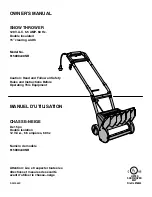
100680 - 27 iN. 2-STAgE SNOwbLOwER
ASSEMbLY
18
3. Align the lever and the gear, and then connect the R-clip
(11-1). (Fig. 11B).
4. Check the snow discharge chute by turning it fully in both
directions. The discharge chute should rotate freely.
11–1
Figure 11B
wARNiNg
Ensure the R pin is positioned as shown in Fig. 11B.
Add Engine Oil
wARNiNg
DO NOT attempt to crank or start the engine before it has been
properly filled with the recommended type and amount of oil.
Damage to the snowblower as a result of failing to follow these
instructions will void your warranty.
NOTiCE
The snowblower rotor has a sealed, pre-lubricated ball bearing
that requires no additional lubrication for the life of the bearing.
NOTiCE
The recommended oil type for typical use is
0W-30
automotive oil
.
If running snowblower in extreme temperatures, refer to the
following chart for recommended engine oil type.
-20
0
20
40
60
Ambient temperature
Recommended Engine Oil Type
80
100
120
-28.9
°F
°C
-17.8 -6.7 4.4
15.6 26.7 37.8
48.9
10W-30
5W-30 Synthetic
10W-40
5W-30
1. Place the snowblower on a flat, level surface.
2. Remove the oil cap/dipstick and wipe it clean (Fig. 12A).
Oil fill and level
check cap
Figure 12A
3. Insert the oil cap/dipstick into the oil filler neck but do not
screw it in, then remove it to check the oil level (Fig. 12B).
Oil Needed
Oil Fill
Figure 12B
4. If the oil level is near or below the lower limit mark on
the dipstick, remove the oil cap/dipstick, and fill with the
recommended oil to the upper limit mark. Do not overfill
(Fig. 12B).
5. Reinstall the oil cap/dipstick.
NOTiCE
Once oil has been added, a visual check should show oil about
1-2 threads from running out of the fill hole.
When using the dipstick to check oil level, DO NOT screw in
the dipstick while checking.
NOTiCE
Check oil level often during the initial 20 hour engine run
period. Refer to the
Maintenance
section for recommended
service intervals.
















































